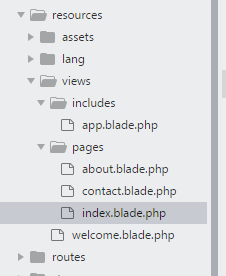Laravel follows Model view controller pattern.
-
- Controller – Interact with Model and view.
- Model – Handles database manipulation.
- View – Display final UI to the user from where it can interact with the application.
Laravel comes with Blade templating engine which makes easier to create pages. Blade view file compiled into plain PHP code.
Blade view files has .blade.php extension.
You can use PHP code in it.
I am assuming you have already created a Laravel project if not then you can view my earlier tutorial.
In this tutorial, I will create a simple application where pass data to view.
Contents
1. Create Controller
Controller files are managed in app/Http/Controllers/ directory.
- Open Command Prompt.
- Navigate to project directory.
- Now, execute
php artisan make:controller PagesController. Here, I createdPagesController.
- A new controller is created in
app/Http/Controllersdirectory.
Syntax – Load a View
view([ view-name ]);
Syntax – Pass data to View
1.compact() –
Pass single value
view([ view-name ], compact( variable-name ));
Multiple values
view([ view-name ], compact( [variable-name1,variable-name2,...] ));
2. with() –
Pass single value
view([ view-name ])->with(key-name, value);
Multiple values
view([ view-name ])->with( [key-name1 => value1, key-name2 => value2, ...]);
In the controller, I created 3 methods to load a view and pass data.
1. index() – Load index view and pass $titleName.
2. about() – Load about view and pass $title.
3. contact() – Load contact view and pass $data array where initialize title key.
NOTE – If view file is stored in another directory inside
views/directory then it will locate using(.)symbol e.g.pages.index. Here,pagesis a directory name andindexis view file name.
Completed Code
<?php
namespace App\Http\Controllers;
use Illuminate\Http\Request;
class PagesController extends Controller{
public function index(){
$titleName = "HomePage";
return view('pages.index',compact('titleName'));
}
public function about(){
$title = "About Us";
return view('pages.about')->with('title', $title);
}
public function contact(){
$data = array();
$data['title'] = "Contact";
return view('pages.contact')->with($data);
}
}
2. Route
Need to define the route to access the pages.
Open web.php in routes/ directory.
Here, I defined 3 routes for the homepage, about, and contact.
Completed Code
<?php
// Controller-name@method-name
Route::get('/', 'PagesController@index'); // localhost:8000/
Route::get('/about', 'PagesController@about'); // localhost:8000/about
Route::get('/contact', 'PagesController@contact'); // localhost:8000/contact
3. Views
Views files are managed in resources/views/ directory.
I created separated directories – includes, and pages to manage views files.
Here, created 4 files –
- includes/app.blade.php
- pages/index.blade.php
- pages/about.blade.php
- pages/contact.blade.php
includes/app.blade.php
This is a template file which will extend on index, about, and contact views.
Here, create a common layout for pages but the make content section dynamic.
For this use @yield('content') where pass the string value. This is specified using @section in other views pages.
NOTE – This layout is extend on other pages using
@extends('includes.app'). The content is specify between@section('content')and@stopwhich will replace@yield('content').
Completed Code
<!doctype html>
<html>
<head>
<title>Laravel Application</title>
<link rel="stylesheet" href="https://maxcdn.bootstrapcdn.com/bootstrap/3.3.7/css/bootstrap.min.css">
<script src="https://ajax.googleapis.com/ajax/libs/jquery/3.3.1/jquery.min.js"></script>
<script src="https://maxcdn.bootstrapcdn.com/bootstrap/3.3.7/js/bootstrap.min.js"></script>
</head>
<body>
<nav class="navbar navbar-inverse">
<div class="container-fluid">
<div class="navbar-header">
<a class="navbar-brand" href="/">Makitweb</a>
</div>
<ul class="nav navbar-nav">
<li><a href="/">Home</a></li>
<li><a href="/about">About Us</a></li>
<li><a href="/contact">Contact Us</a></li>
</ul>
</div>
</nav>
<div class='container'>
<div class='row'>
@yield('content')
</div>
</div>
</body>
</html>
pages/index.blade.php
Extends the app view which is stored in includes/ directory using @extends('includes.app').
Specify HTML content between @section('content') and @stop. This replaces the @yield('content') in the template file.
In <h1> tag pass $titleName between {{ }} which is passed from the controller.
NOTE – The
@section([value])contains[value]is defined value in@yield([value]).
Completed Code
<!-- Extends template page from includes directory-->
@extends('includes.app')
<!-- Specify content -->
@section('content')
<h1>{{$titleName}}</h1>
<p>Page Content</p>
@stop
pages/about.blade.php
@extends('includes.app') App template.
Specify HTML content between @section('content') and @stop.
In <h1> tag pass $title between {{ }} which is passed from the controller.
Completed Code
<!-- Extends template page from includes directory-->
@extends('includes.app')
<!-- Specify content -->
@section('content')
<h1>{{$title}}</h1>
<p>Page Content</p>
@stop
pages/contact.blade.php
@extends('includes.app') App template.
Specify HTML content between @section('content') and @stop.
In <h1> tag pass $title between {{ }} which is passed from the controller.
Also, create a <form > with some input element.
Completed Code
<!-- Extends template page from includes directory-->
@extends('includes.app')
<style>
table td{
padding-bottom: 10px;
}
</style>
<!-- Specify content -->
@section('content')
<h1>{{$title}}</h1>
<form>
<table width='100%'>
<tr>
<td>Name</td>
<td><input type='text' class='form-control' name='name'></td>
</tr>
<tr>
<td>Subject</td>
<td><input type='text' class='form-control' name='subject'></td>
</tr>
<tr>
<td>Content</td>
<td><textarea class='form-control' name='content'></textarea></td>
</tr>
<tr>
<td></td>
<td><input type='button' class='btn btn-info' value='Submit' ></td>
</tr>
</table>
</form>
@stop
4. Output
5. Conclusion
Define template layout if you want common layout across all pages with dynamic content. Extend it on the page where require.
You can either pass data from the controller using compact() or with() while loading the view.
I not used Model in this tutorial, which I show in the upcoming tutorial with database manipulation.
If you found this tutorial helpful then don't forget to share.




